Dartmouth, Nova Scotia
Dartmouth (/ˈdɑːrtməθ/ DART-məth) is a former city and current community located in the Halifax Regional Municipality of Nova Scotia, Canada. Dartmouth is located on the eastern shore of Halifax Harbour. Dartmouth has been nicknamed the City of Lakes, after the large number of lakes located within its boundaries.
Dartmouth | |
|---|---|
 Downtown Dartmouth skyline from the Halifax ferry, showing the ferry terminal, the World Peace Pavilion, and the King's Wharf development. | |
| Nicknames: City of Lakes, "The Darkside"[1] | |
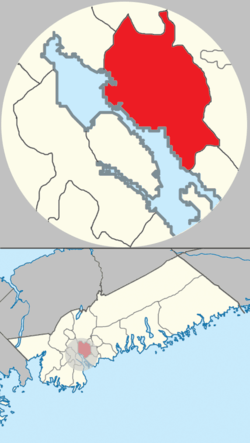 Location of Dartmouth, shown in red | |
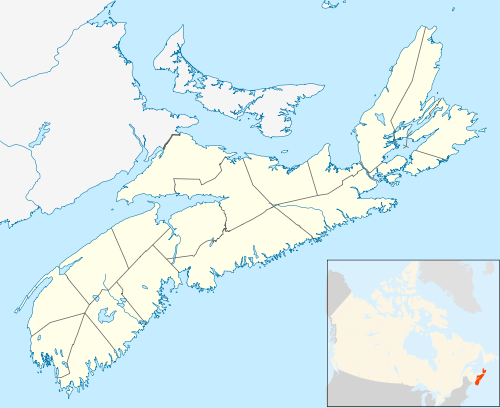 Dartmouth Location of Dartmouth, Nova Scotia 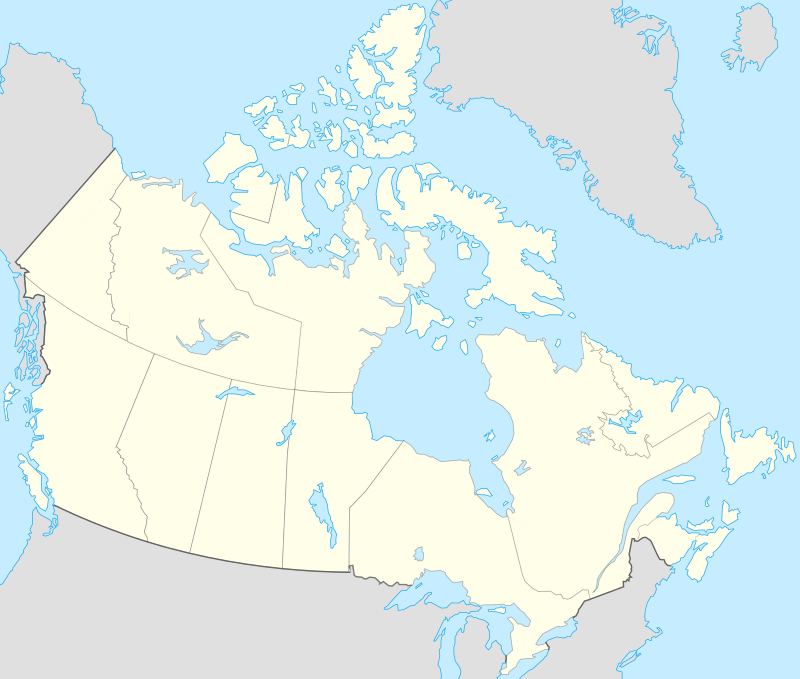 Dartmouth Dartmouth (Canada) | |
| Coordinates: 44°40′0″N 63°34′0″W | |
| Country | Canada |
| Province | Nova Scotia |
| Municipality | Halifax |
| Founded | 1750 |
| Incorporated City | January 1, 1961 |
| Amalgamated with Halifax | April 1, 1996 |
| Neighbourhoods | Albro Lake, Bell Ayr Park, Brightwood, Burnside, Commodore Park, Crichton Park, Crystal Heights, Downtown Dartmouth, Ellenvale, Grahams Corner, Greenough Settlement, Harbourview, Highfield Park, Imperoyal, Keystone Village, Lancaster Ridge, Manor Park, Montebello, Nantucket, Port Wallace, Portland Estates, Portland Hills, Shannon Park, Southdale, Tam O'Shanter Ridge, Tufts Cove, Wallace Heights, Woodlawn, Woodside |
| Government | |
| • Governing Body | Halifax Regional Council |
| • Community Council | Harbour East - Marine Drive Community Council |
| • Districts | 3 - Dartmouth South - Eastern Passage. 5 - Dartmouth Centre. 6 - Harbourview - Burnside - Dartmouth East |
| Area | |
| • Total | 58.57 km2 (22.61 sq mi) |
| Highest elevation | 113 m (371 ft) |
| Lowest elevation | 0 m (0 ft) |
| Population (2001)[2] | |
| • Total | 65,741 |
| • Density | 1,122.4/km2 (2,907/sq mi) |
| Demonym(s) | Dartmouthian |
| Time zone | UTC−04:00 (AST) |
| • Summer (DST) | UTC−03:00 (ADT) |
| Postal code span | B2V to B2Z, B3A-B |
| Area code(s) | 902 |
| Telephone Exchanges | 433-5, 460-6, 468-9, 481 |
| GNBC Code | CAIYJ |
| NTS Map | 011D12 |
Part of a series about Places in Nova Scotia | |
On April 1, 1996, the provincial government amalgamated all the municipalities within the boundaries of Halifax County into a single-tier regional government named the Halifax Regional Municipality (HRM). Dartmouth and its neighbouring city of Halifax, the town of Bedford and the Municipality of the County of Halifax were dissolved. The city of Dartmouth forms part of the urban core of the larger regional municipality and is officially designated as part of the "capital district" by the Halifax Regional Municipality. At the time that the City of Dartmouth was dissolved, the provincial government altered its status to a separate community to Halifax; however, its status as part of the metropolitan "Halifax" urban core existed prior to municipal reorganization in 1996.
Dartmouth is still an official geographic name that is used by all levels of government for legal purposes, postal service, mapping, 9-1-1 emergency response, municipal planning, and is recognized by the Halifax Regional Municipality as a civic addressing community. The official place name did not change, due to the confusion with similar street names, land use planning set out by the former "City of Dartmouth," and significant public pressure. Today the same development planning for Downtown Dartmouth and the rest of the region is still in force, as well as specific bylaws created prior to April 1, 1996.
History
.jpg)
Father Le Loutre's War began when Edward Cornwallis arrived to establish Halifax with 13 transports on June 21, 1749.[3] By unilaterally establishing Halifax, the British were violating earlier treaties with the Miꞌkmaq (1726), which were signed after Father Rale's War.[4] The British quickly began to build other settlements. To guard against Miꞌkmaq, Acadian and French attacks on the new Protestant settlements, British fortifications were erected in Halifax (1749), Dartmouth (1750), Bedford (Fort Sackville) (1751), Lunenburg (1753) and Lawrencetown (1754).
In 1750, the sailing ship Alderney arrived with 151 immigrants. Municipal officials at Halifax decided that these new arrivals should be settled on the eastern side of Halifax Harbour. During the early years, there were 8 Acadian and Miꞌkmaq raids on the new British settlement, such as the Raid on Dartmouth (1751).
The original settlement was made in an area the Miꞌkmaq called Ponamogoatitjg[5] (Boonamoogwaddy), which has been varyingly translated as "Tomcod Ground" or "Salmon Place" in reference to the fish which were presumably caught in this part of Halifax Harbour. The community was later given the English name of Dartmouth in honour of William Legge, 1st Earl of Dartmouth who was a former Secretary of State. By 1752, 53 families consisting of 193 people lived in the community.
Dartmouth was initially a sawmill and agricultural outpost of Halifax. However, in the mid 19th century, it grew, first with the construction of the Shubenacadie Canal and more importantly with the rise of successful industrial firms such as the Dartmouth Marine Slips, the Starr Manufacturing Company, and the Stairs Ropeworks.
In 1873, Dartmouth was incorporated as a town and a Town Hall was established in 1877. In 1955, the town was permanently linked to Halifax by the Angus L. Macdonald Bridge which led to rapid suburban growth. The Town of Dartmouth amalgamated with several neighbouring villages into the City of Dartmouth in 1961. The A. Murray MacKay Bridge opened in 1970, furthering commercial and residential growth. The Dartmouth General Hospital opened in 1976.
The city was dissolved on April 1, 1996, when its government was amalgamated into the Halifax Regional Municipality.
| Year | Pop. | ±% |
|---|---|---|
| 1762 | 10 | — |
| 1881 | 3,786 | +37760.0% |
| 1891 | 6,252 | +65.1% |
| 1901 | 4,806 | −23.1% |
| 1911 | 5,058 | +5.2% |
| 1921 | 7,899 | +56.2% |
| 1931 | 9,100 | +15.2% |
| 1941 | 10,847 | +19.2% |
| 1951 | 15,037 | +38.6% |
| 1961 | 46,966 | +212.3% |
| 1981 | 62,333 | +32.7% |
| 1986 | 65,243 | +4.7% |
| 1991 | 67,798 | +3.9% |
| 1996 | 65,629 | −3.2% |
| 2001 | 65,741 | +0.2% |
| [6][7][8][9][10][11] Population figures reflect the 1961 amalgamation. | ||
Municipal government
Dartmouth is represented municipally in Halifax Regional Council by the following districts:
- District 3 - Dartmouth South - Eastern Passage
- District 5 - Dartmouth Centre
- District 6 - Harbourview - Burnside - Dartmouth East

The HRM community council for Dartmouth is the Harbour East - Marine Drive Community Council are held in various locations on the first Thursday of every month.
Residents of Dartmouth are known as Dartmouthians. As a community, Dartmouth has often tended to distinguish itself from the community and former city of Halifax, even under the present municipal amalgamation. Dartmouth is also the Halifax Regional Municipality's Public Works Eastern Region.
Economy
The city was not only a bedroom community for Halifax, but also had commerce and industries of its own, including the Volvo Halifax Assembly plant, and a molasses plant dating back to the days of the triangular trade with the West Indies. Today, Dartmouth is home to the shopping district of Dartmouth Crossing, as well as federal government offices, many located in the Queen Square building on Alderney Drive.
Transportation and communications
Transportation
Dartmouth is linked to Halifax by the oldest continuously operating salt water ferry service in North America with the first crossing having taken place in 1752. Early ferries were powered by horses, which were replaced with steam engines in 1830. During the early 20th century, ferries shuttled pedestrians and vehicles between the downtown areas of Halifax and Dartmouth. A railway trestle was built across Halifax Harbour in the late 19th century to bring rail service to Dartmouth however it was destroyed by a storm, requiring the present railway connection built around Bedford Basin.
During the early 1950s, construction began on the Angus L. Macdonald Bridge, a suspension bridge crossing Halifax Harbour. It opened in 1955, ushering in an unprecedented development boom in Dartmouth. New subdivisions, shopping centres, office buildings and industrial parks have been built in recent decades. A second bridge, the A. Murray MacKay Bridge was opened in 1970 and the Highway 111 Circumferential Highway was built around Dartmouth to Woodside at this time.
Communications
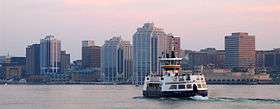
- The first three digits of the postal codes are B2V, B2W, B2X, B2Y, B3A, B3B
- The telephone exchanges are 902: 462, 463, 433, 434, 435, 461, 464, 465, 466, 468, 469 - Bell Aliant; 404, 407, 431, 444, 446, 478, 497, 225, 229 - Eastlink; 401, 402, 405, 406, 412, 441, 449 - Rogers Wireless; 209, 802, 830, 877 - Telus
- Internet: Cable - Eastlink; DSL - Bell Aliant
- Cable TV - Eastlink, Bell Aliant
Natal Day
- Dartmouthians celebrate a civic holiday known as "Natal Day" since August 1895. The concept originated as a means to celebrate the arrival of the railway, but construction of the railway tracks was incomplete on the appointed day. Since all the preparations for the festivities were ready, organizers decided to go ahead with a celebration of the municipality's birthday instead.
- In 1941, the Dartmouth Natal Committee decided to erect a cairn in honour of the spirit and courage of the first English settlers to Dartmouth's shore. It is situated in Leighton Dillman Park, part of the common lands left to the community by the Quakers, and it overlooks the harbour where the first settlers built their homes. The monument stands three meters high and is constructed from rocks gathered on Martinique Beach. A plaque in front of the cairn is inscribed and describes the arrival of the Alderney "on August 12, 1750 with 353 settlers."
Demographics
The former City of Dartmouth, at the time of the 1996 census, covered 58.57 km2 and housed 65,629 people.[12] After 1 April 1996, the former city was turned into an urban community of the Halifax Regional Municipality. As of 2016, the area of the former City of Dartmouth increased to 60.36 km2, and grew in population to 68,407 people. The former City of Dartmouth consisted of census-tracts 2050100.00-to-2050114.00.[13]
| Census Tract | Land Area (km2) | Population | Population Density (per km2) | |
|---|---|---|---|---|
| 2050100.00 | 5.86 | 3,855 | 657 | |
| 2050101.00 | 1.67 | 3,343 | 2,001 | |
| 2050102.00 | 1.32 | 4,623 | 3,502 | |
| 2050103.00 | 1.89 | 4,228 | 2,237 | |
| 2050104.01 | 1.24 | 2,015 | 1,625 | |
| 2050104.02 | 4.85 | 8,522 | 1,757 | |
| 2050105.01 | 1.19 | 3,082 | 2,589 | |
| 2050105.02 | 2.11 | 4,613 | 2,186 | |
| 2050106.01 | 1.56 | 3,538 | 2,267 | |
| 2050106.02 | 8.96 | 5,106 | 569 | |
| 2050107.00 | 1.54 | 3,000 | 1,948 | |
| 2050108.00 | 2.27 | 4,769 | 2,100 | |
| 2050109.00 | 1.27 | 3,200 | 2,519 | |
| 2050110.00 | 0.81 | 1,481 | 1,828 | |
| 2050111.00 | 0.97 | 3,132 | 3,228 | |
| 2050112.00 | 1.65 | 2,014 | 1,220 | |
| 2050113.00 | 3.06 | 1,317 | 430 | |
| 2050114.00 | 18.14 | 6,569 | 362 | |
| Total | 60.36 | 68,407 | 1,133 | Former City of Dartmouth |
| Data cited from 2016.[14] |
Geography
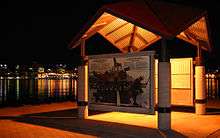

Neighbourhoods of Dartmouth include:
- Albro Lake
- Bel Ayr Park
- Brightwood
- Burnside
- Commodore Park
- Cranberry
- Crichton Park
- Crystal Heights
- Dartmouth Crossing
- Downtown Dartmouth
- Ellenvale
- Grahams Corner
- Greenough Settlement
- Harbourview
- Highfield Park
- Imperoyal
- Manor Park
- Montebello
- Nantucket
- Notting Park
- Port Wallace
- Portland Estates
- Portland Hills
- Russell Lake West
- Shannon Park
- Southdale
- Tam O'Shanter Ridge
- Tufts Cove
- Wallace Heights
- Westphal
- Wildwood Lake
- Woodlawn
- Woodside
The oldest structure in Dartmouth is the house of William Ray, a Quaker and cooper[15] from Nantucket who moved to Dartmouth in 1785-86 as a whaler. Its materials and construction methods closely resembles Quaker architecture in Nantucket, such as the asymmetrical facade design and stone foundation.[16] It is located at 59 Ochterloney Street and is believed to have been built around 1785 or 1786. Today it is a museum, furnished as a typical modest dwelling of a merchant of that time.[16][17]
Dartmouth's City hall was built in the early 1960s on the waterfront adjacent to the Alderney Ferry Terminal. The building was declared surplus and sold to Starfish Properties and will be redeveloped.[18]
Military
Dartmouth has been home to several Canadian Forces installations:
- CFB Shearwater, located on the southern border of Dartmouth is an air force base, formerly known as Naval Air Station Halifax, RCAF Station Dartmouth, RCAF Station Shearwater, HMCS Shearwater, and RCNAS Shearwater.
- HMC Naval Radio Station Albro Lake, a radio transmitter/receiver facility.
- CFB Halifax adjunct, an area on the Dartmouth waterfront opposite HMC Dockyard.
- Wallace Heights, a former military housing area in north-end Dartmouth.
- Shannon Park, unused military housing area in north-end Dartmouth.
- Canadian Forces Ammunition Depot Bedford, a munitions magazine for Maritime Forces Atlantic, located on the border between Dartmouth and Bedford.
Notable people
- Scott Frederick Cameron, 35th Canadian Surgeon General
- Custio Clayton, boxer
- Steve Giles, Olympic paddler
- Vince Horsman, former MLB pitcher
- Michael Jackson, actor, Trailer Park Boys
- Mike Johnston, NHL/WHL Hockey Coach
- Ruby Keeler, 1930s Hollywood starlet
- Chris Kelades, Mixed martial arts and UFC fighter
- Don Koharski, former NHL referee
- Wendy Lill, playwright, represented Dartmouth as a two-term New Democratic Party Member of Parliament
- Kevin MacMichael, musician, Cutting Crew guitarist, attended Dartmouth High School
- Matt Mays, indie rock musician
- Christian Murray, actor, writer
- Arnie Patterson, broadcaster (CFDR and Q104 radio) and former press secretary to Prime Minister of Canada Pierre Trudeau.[19]
- Constance Piers (1866–1939), journalist, poet, editor
- Joel Plaskett, indie rock musician
- Andrew Russell, Olympic sprint canoeist
- John Paul Tremblay, actor, Trailer Park Boys
- James Tupper, actor
- Robb Wells, actor, Trailer Park Boys
- Lindell Wigginton, basketball player, Minnesota Timberwolves
Symbols
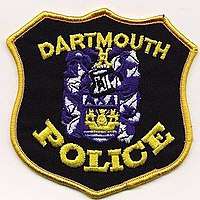
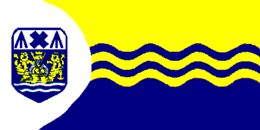
- Dartmouth is nicknamed "The City of Lakes". Boasting 23 lakes within its boundaries, Dartmouthians take special pride in the chain of lakes within its boundaries that form part of the Shubenacadie Canal. Most famous amongst these is Lake Banook, which provides an excellent location for recreation as well as attractive vistas. Dartmouth's most historic body of water is the artificial Sullivan's Pond, located north-east of the downtown area on Ochterloney Street. It was dug in the 1830s as part of the Shubenacadie Canal to connect Halifax Harbour with Cobequid Bay on the Bay of Fundy.
- Dartmouth was Halifax's sister city. Halifax's city flower is the broad-chested rose. Dartmouth's city flower is the orchid.
- Dartmouth's Motto is located on its City Crest "Amicitia Crescimus."
Culture
- The television show Trailer Park Boys is set in a fictional Dartmouth trailer park and filmed in Dartmouth and its environs. The show features actors (such as Robb Wells) and writers from Dartmouth. A documentary film about the creation and production of the Trailer Park Boys series is entitled Hearts of Dartmouth.
- The television show Diggstown is filmed in and around Dartmouth.
- The community hosted the ICF Canoe Sprint World Championships in 1997 and 2009 and with Halifax co-hosted the initial Canada Summer Games in 1969.
References
- "Archived copy". Archived from the original on 2016-08-08. Retrieved 2016-06-19.CS1 maint: archived copy as title (link)
- "2001 Census Profile: Dartmouth, Nova Scotia". Statistics Canada. Retrieved February 20, 2020.
- Grenier, John. The Far Reaches of Empire. War in Nova Scotia, 1710-1760. Norman: U of Oklahoma P, 2008; Thomas Beamish Akins. History of Halifax, Brookhouse Press. 1895. (2002 edition). p 7
- Wicken (2002), p. 181; Griffith, p. 390; Also see "Archived copy". northeastarch. Archived from the original on 2013-05-14. Retrieved 2014-02-05.CS1 maint: archived copy as title (link)
- Wicken, William C. (2002). Mi'kmaq Treaties on Trial: History, Land and Donald Marshall Junior. University of Toronto Press. p. 174. ISBN 978-0-8020-7665-6.CS1 maint: ref=harv (link)
- 1762 Census
- 104.pdf Archived April 23, 2016, at the Wayback Machine, Canada Year Book 1932
- 140.pdf Archived January 14, 2016, at the Wayback Machine, Canada Year Book 1955
- "Archived copy" (PDF). Archived from the original (PDF) on 2014-12-23. Retrieved 2014-08-30.CS1 maint: archived copy as title (link), Canada Year Book 1967
- , 1996 Census of Canada: Electronic Area Profiles
- , 2001 Community Profiles
- "Electronic Area Profiles". Statistics Canada. Statistics Canada. Retrieved 20 May 2020.
- "Halifax". University of Toronto. University of Toronto. Retrieved 20 May 2020.
- "Halifax Open Data". halifax.ca. Government of the Municipality of Halifax.
- "HistoricPlaces.ca - HistoricPlaces.ca". www.historicplaces.ca. Retrieved 2017-05-03.
- Dartmouth Heritage Museum
- Historic Places Canada
- http://thechronicleherald.ca/business/1465950-former-dartmouth-city-hall-gets-a-new-lease-on-life
- "Arnie Patterson: Trudeau, rock 'n' roll and the Springhill Mine Disaster". The Globe and Mail. March 30, 2011. Retrieved 2014-04-26.
External links
| Wikimedia Commons has media related to Dartmouth, Nova Scotia. |
| Wikisource has the text of the 1920 Encyclopedia Americana article Dartmouth. |

- Official Halifax Municipal Government website
- Former Dartmouth City Flag
- The Miracle of Woodside 4 June 1965
- Forest Hills Fellowship Baptist Church of Dartmouth, Nova Scotia
- Hello Dartmouth - Community News Group
- . Encyclopædia Britannica (11th ed.). 1911.